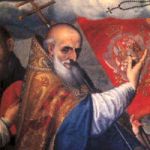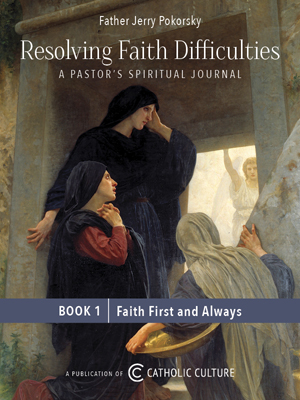Make your gift today!
Help keep Catholics around the world educated and informed.
Already donated? Log in to stop seeing these donation pop-ups.
Introducing the Church Fathers
By Thomas V. Mirus ( bio - articles - email ) | Jul 27, 2014 | In Fathers of the Church
Several years ago, CatholicCulture.org processed and made available online a set of the writings of the Fathers of the Church. In order to make our readers aware of this under-used resource, and because the Fathers are still too little known despite their importance as a font of authentic Christian renewal, I will be posting a series of articles introducing the Fathers in chronological order.
Who are the Fathers?
Despite how the Qu’ran describes us, Christians are not “people of the book,” but people of the Word. While the New Testament, being divinely inspired, has pride of place as a primary source of Revelation, it is far from being the only authoritative source of Christian truth. This must be the case, since Christians were practicing their faith for decades before the books of the New Testament were written and for centuries before they were organized into a canon. Christianity began as an oral tradition entrusted to Peter and the Apostles by Christ, and it is only by the authority of the successors of the Apostles, exercised in a series of councils, that certain books were confirmed to be part of sacred Scripture, their authenticity and divine inspiration guaranteed.
Aside from the New Testament and the documents of various Church councils, our main ways of knowing about the early Church are liturgical sources, such as the Apostles’ Creed, and the writings of the men who became known as the Fathers of the Church. Originally, it was the bishops who were called Fathers, as religious leaders and chief teachers of the Faith, but eventually the term broadened to include ecclesiastical writers who were not bishops.
Unlike Doctor of the Church, Father of the Church is not an official title; today there are four basic criteria that determine whether a figure is considered a Father. These are orthodoxy, holiness of life, ecclesiastical approval, and antiquity. However, some writers who do not satisfy these criteria perfectly, such as Origen, Tertullian, and Eusebius of Caesarea, are still considered Fathers because of their great contributions to the Church. Indeed, there were some Fathers who fell into doctrinal error, but this was at a time when many doctrinal questions had not been definitively settled, and it is possible to hold to material (de facto) heresy while still being committed to orthodoxy.
The criterion of antiquity is somewhat flexible. The patristic era is conventionally divided into three periods. The first is that of the origins of Christianity, critically important because of the presence of early Christian witnesses. This is the period to which one must look in order to weigh the claims of the various Christian denominations that theirs is the faith practiced by the earliest Christians. It includes the non-canonical writings of the Apostolic Fathers, men who knew the Apostles or their direct successors personally, and extends into the third century A.D.
The second period, considered the patristic golden age, begins in 300 with St. Athanasius and ends with the death of St. Augustine in 430. This was a great period of doctrinal development, in which the great Christian thinkers clashed with various heresies and settled important questions on topics such as grace and the Trinity.
The third and last period has no clearly defined end, but is generally considered to have ended in the West with the death of St. Isidore of Seville in 636, and in the East with the death of St. John of Damascus (Damascene) in 749. In addition to noting the Christological controversies that played out in the beginning of this period, Patrick J. Hamell writes:
The authors of this age formed a link between the falling ancient world and the coming new world, and reach out to the men who were to enlighten the barbarians, to St. Gregory the Great in Italy, St. Gregory of Tours in Gaul, St. Isidore in Spain, the Venerable Bede in England. [Handbook of Patrology, 1968, p. 11]
(It should be noted here that many other ecclesiastical writers of the patristic era who would not necessarily be considered Fathers will also be covered in this series.)
The bulk of the Fathers are divided into Latin and Greek Fathers after the two major languages of ecclesiastical writing in this period of the Church’s history (though there are also writings Syriac, Armenian and Coptic). Both Western and Eastern Christianity have four figures called the “Great Church Fathers.” These are Sts. Ambrose, Jerome, Augustine, and Gregory the Great in the West, and Basil the Great, Athanasius, Gregory of Nazianzus (Nazianzen) and John Chrysostom in the East. The Roman Catholic Church calls these the “Eight Doctors of the Church,” to which more have been added in the past few centuries.
Why Study the Fathers?
By now some reasons to study these men are probably clear to the reader. Familiarity with the Fathers is familiarity with Christian doctrine as it developed in the Church’s early centuries. By studying their writings in the context of their lives and the times in which they lived, one learns the history of the early Church and the various great and numerous challenges it confronted. And not only were the Fathers some of the greatest minds in the history of the Church, they are also (for the most part) saints, and immense spiritual value can be derived from their writings.
From all this it is clear that the Fathers may speak to us with considerable authority on matters of Christian doctrine. It may be asked, however, whether they possess any authority of an absolute or official kind. The Church’s teaching here is that the unanimis consensus patrum in the interpretation of Scripture is infallible. Echoing the Council of Trent, the first Vatican Council, in its Dogmatic Constitution Concerning the Catholic Faith (session 3, chapter 2), declared:
That must be considered as the true sense of Scripture which Holy Mother Church has held and holds, whose office it is to judge concerning the true understanding and interpretation of the Sacred Scriptures; and, for that reason, no one is permitted to interpret Sacred Scripture itself contrary to this sense, or even contrary to the unanimous agreement of the Fathers.
Blessed John Henry Newman writes eloquently on the significance of Patristic unanimity:
I follow the ancient Fathers, not as thinking that on such a subject they have the weight they possess in the instance of doctrines or ordinances. When they speak of doctrines, they speak of them as being universally held. They are witnesses to the fact of those doctrines having been received, not here or there, but everywhere. We receive those doctrines which they thus teach, not merely because they teach them, but because they bear witness that all Christians everywhere then held them. We take them as honest informants, but not as a sufficient authority in themselves, though they are an authority too. If they were to state these very same doctrines, but say, “These are our opinions: we deduced them from Scripture, and they are true,” we might well doubt about receiving them at their hands. We might fairly say, that we had as much right to deduce from Scripture as they had; that deductions of Scripture were mere opinions; that if our deductions agreed with theirs, that would be a happy coincidence, and increase our confidence in them; but if they did not, it could not be helped—we must follow our own light. Doubtless, no man has any right to impose his own deductions upon another, in matters of faith. There is an obvious obligation, indeed, upon the ignorant to submit to those who are better informed; and there is a fitness in the young submitting implicitly for a time to the teaching of their elders; but, beyond this, one man’s opinion is not better than another’s. But this is not the state of the case as regards the primitive Fathers. They do not speak of their own private opinion; they do not say, “This is true, because we see it in Scripture”—about which there might be differences of judgment—but, “this is true, because in matter of fact it is held, and has ever been held, by all the Churches, down to our times, without interruption, ever since the Apostles”: where the question is merely one of testimony, viz., whether they had the means of knowing that it had been and was so held; for if it was the belief of so many and independent Churches at once, and that, on the ground of its being from the Apostles, doubtless it cannot but be true and Apostolic.
Two Millennia of Scholarship
The importance of the early ecclesiastical writers was well understood even by their contemporaries. Eusebius, in his fourth-century Ecclesiastical History, lists all the Christian writers and writings of which he knows, including quotations, many of the sources of which are no longer extant – in many cases, we only know of these writings from Eusebius’s work.
St. Jerome, too, was concerned to catalogue the existing Christian literature, in order to show pagans that the Christian intellectual tradition was far from negligible. In his De viris illustribus of 392, he did just that, including a description and appraisal of each writer. Jerome included heretical writers in his list (prompting a letter from St. Augustine, concerned that Jerome hadn’t bothered to distinguish the heretics from the orthodox), as well as a few Jewish and pagan writers such as Philo, Josephus and Seneca. Over the next millennium, many additions to this work were written by authors including Gennadius (480), St. Isidore of Seville (615-618), and Sigebert of Gembloux (d. 1112).
The sixteenth and seventeenth centuries saw the appearance of the first great collections and special editions of ecclesiastical writings. It was during the mid-nineteenth century, though, that the Abbé Migne compiled and published the Patrologiae Cursus Completus, a massive collection of hundreds of volumes which goes up through the Council of Florence in 1439. Despite its many flaws in editing and translation, this collection is still used by scholars of Patristics, and has undergone numerous expansions and revisions in the century-and-a-half since its publication. The nineteenth century also saw many new discoveries of ancient texts warranting the creation of new critical editions and collections, since Migne’s collection consisted of reprints of old editions and therefore did not include any newly found texts. The recovery of many lost works, especially Oriental ones, has continued since.
The collection we have on CatholicCulture.org was originally published beginning in 1867 by Eerdmans, an Anglican publisher in Edinburgh, Scotland. While imperfect and outdated, this collection is in the public domain and includes many of the great Patristic texts. I will make reference to these texts where appropriate in the course of this overview of the Fathers, though I will occasionally use quotes from other translations as well.
Next in series: The Didache and the Epistle of Barnabas
All comments are moderated. To lighten our editing burden, only current donors are allowed to Sound Off. If you are a current donor, log in to see the comment form; otherwise please support our work, and Sound Off!








